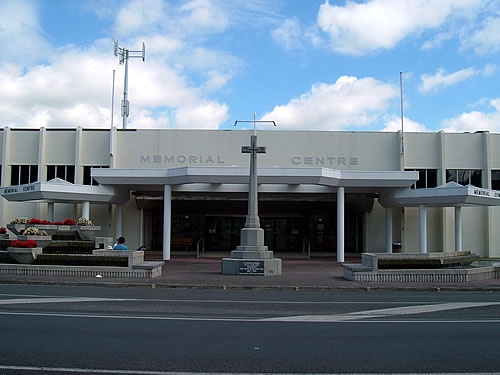
Matamata’s first war memorial was a group of four memorial oak trees planted in the domain in 1917 to commemorate four local men who died at Gallipoli: Trooper Watson, Corporal R.N. Wild, Corporal J. Bradley, and Trooper N. Maisey. For several years after the war a temporary cenotaph was erected for Anzac Day ceremonies held in front of the Matamata Town Hall, at the junction of Hetana and Arawa streets. A Matamata roll of honour unveiled in the hall on Anzac Day 1925 listed about 130 names.
On 10 December 1926 Governor-General Sir Charles Fergusson unveiled a permanent war memorial cross in front of the town hall. The cross was made of Coromandel granite and inscribed with the names of 39 fallen.
In 1947 Matamata’s citizens decided on a community centre as their Second World War memorial. On 23 November 1955 Mayor E.T. Stanley laid its foundation stone in Tainui Street. On 24 October 1956 Governor-General Sir Willoughby Norris formally opened the Matamata District War Memorial Centre (usually referred to simply as the ‘Memorial Centre’). During the ceremony Archdeacon F.O. Dawson dedicated a memorial shrine in the foyer.
The shrine was designed by Auckland artist and sculptor Richard Gross. It incorporated a memorial wall of white Hinuera stone blocks inset with six polished marble slabs and a bronze roll of honour. The slabs were inscribed in gold letters (from left to right): “They served / on the sea / on the land / and / in the air”; “1914-1918 / in / Samoa Gallipoli / Palestine Egypt / France Flanders / Germany / and in other parts of the world”; “This shrine is erected / as a tribute to those men of / Matamata and district / who gave their lives during the / World War of 1939-45 / and to those others, men and women / whose devoted services / contributed to final victory” ; “They went from / Turanga O Moana Tirau / Peria Wardville / Okoroire Walton / Te Poi Waharoa / Matamata / Taihoa / Okauia Hinuera” ; ‘1939 – 1945 / in / Middle East Greece / Crete North Africa / Great Britain Italy / Europe Pacific / Far East / and in other parts of the world “ ; “ They served / on the sea / on the land / and / in the air”.
The bronze tablet at the centre of the shrine listed the names of 96 men from Matamata and the above-named localities who gave their lives in the Second World War. It was lit by a bronze lamp of remembrance which stands on a white marble pedestal, surmounted by the New Zealand coat of arms, and bordered by a bronze chain linking the badges of various denominations of the armed forces chaplaincy. The tablet incorporated a quotation from Rupert Brooke: “These laid the world away / Poured out the red sweet wine of youth …[etc.]”
An ‘honours board’ hangs nearby. This lists the names of 407 men and women who left Matamata to serve overseas during the Second World War. (It is not known what happened to town’s First World War roll of honour.)
In 1957 the First World War memorial cross was moved from the town hall to a new position in front of the memorial centre. It has since been updated with plaques honouring service in the Second World War and in J-Force, Korea, Malaya and Vietnam. In 1988 the area around the cross was upgraded with the addition of a fountain and water feature, and better linkage between the cenotaph and the memorial centre.
Sources: ‘The Governor-General’, NZ Herald, 20/11/1926, p. 14; ‘Matamata War Memorial’, Auckland Star, 2/12/1926, p. 15; Joan Stanley, Matamata: Growth of a Town, 1885-1985, Matamata, 1985, pp. 30-1, 81-3; Joan Stanley, Down at the Hall: Celebrating Matamata County Halls, Matamata, 2009, pp. 18-27.










Community contributions